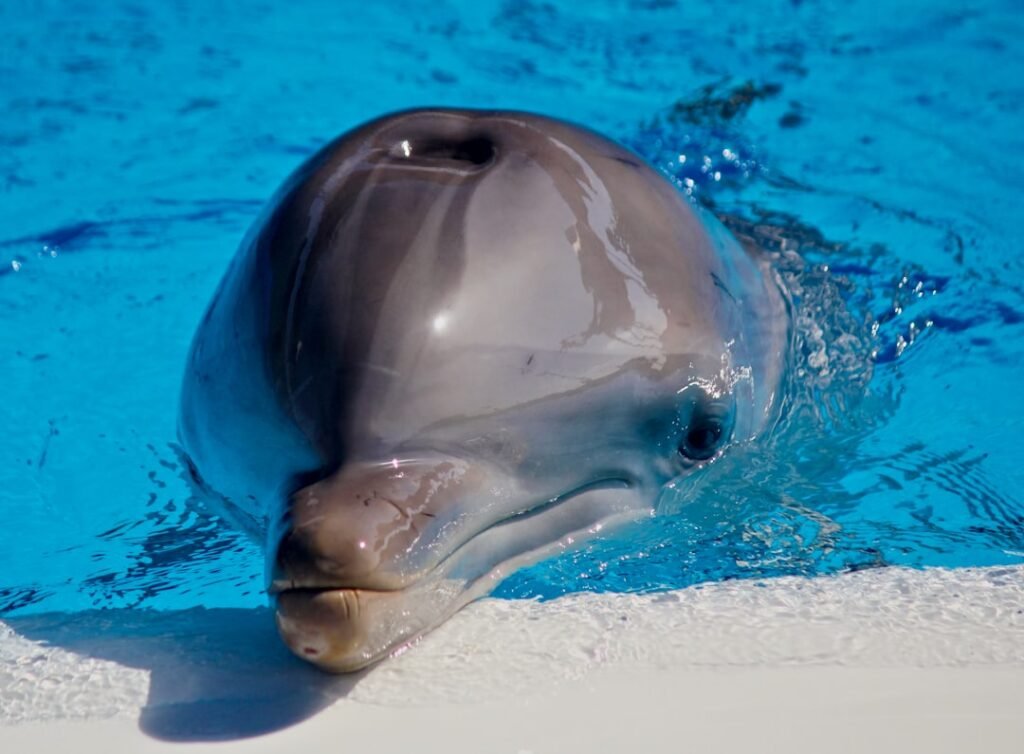You look in the mirror every morning without even thinking about it. That simple act of self-recognition, which feels so effortless and natural, represents one of the most sophisticated cognitive achievements in the animal kingdom. For decades, scientists believed this ability belonged exclusively to humans and our closest relatives, the great apes.
Then something remarkable happened. A landmark 2001 study published in the Proceedings of the National Academy of Sciences indicated that we and our primate relatives are not alone. According to the report, dolphins, too, exhibit mirror self-recognition. This discovery revolutionized our understanding of consciousness and intelligence in marine mammals, revealing cognitive abilities that mirror our own in ways we never imagined possible.
The Revolutionary Mirror Test Breakthrough

To test for dolphin self-awareness, Diana Reiss of Columbia University and Lori Marino of Emory University exposed two bottlenose dolphins to reflective surfaces after marking the dolphins with black ink, applying a water-filled marker (sham-marking) or not marking them at all. This groundbreaking experiment adapted the classic mirror test for use with marine mammals.
We conducted a two-phase experiment to independently test whether two dolphins would use a mirror to view themselves after being marked, sham-marked, or not marked (untouched) in the presence or absence of reflective surfaces. The results were nothing short of extraordinary. Two dolphins were exposed to reflective surfaces, and both demonstrated responses consistent with the use of the mirror to investigate marked parts of the body.
Understanding the Mirror Self-Recognition Test

Mirror self-recognition tests were developed in the 1970s by Gordon Gallup, a professor of psychology at the State University of New York in Albany. In his research, Gallup marked four chimpanzees with dye on their heads. The methodology seems deceptively simple, yet it reveals profound cognitive complexity.
His experiment, which has been used in modified forms ever since, works like this: you first allow the test subjects a few days to familiarize themselves with a mirror. It is during this time that, if the animal is up for the task, it will come to realize that the mirror is a reflection of its own image. Most animals never make this connection. Most animals will display ‘social’ behaviors at the mirror – as if they were encountering another animal, but if the animal manages to catch on to the concept of a mirror, these behavior will stop. After the animal is familiar with the mirror, researchers will give the animal some kind of visible mark on its body. If the animal appears to inspect the mark on its body by using the mirror, then voilà – you have mirror self-recognition.
Dolphin Brain Architecture and Self-Awareness

The dolphin brain presents a fascinating puzzle for neuroscientists studying self-awareness. Bottlenose dolphins have bigger brains than humans (1600 grams versus 1300 grams), and they have a brain-to-body-weight ratio greater than great apes do (but lower than humans). “They are the second most encephalized beings on the planet,” says Marino.
Dolphin brains are not simpler than ours, it now seems; they are just as complex, but in different ways. Since the human and dolphin lineages diverged around 95 million years ago, our two species have independently evolved some of the same basic mental traits: high intelligence, self-awareness, and sophisticated social skills. Smart Cells (5): Dolphins are one of the few species with spindle neurons, cells that act as bridges between brain areas devoted to high-level activities like cognition and self-awareness. These specialized neurons suggest an evolutionary convergence toward complex self-awareness.
The Unique Neural Pathways of Cetacean Self-Recognition

What makes dolphin self-recognition even more remarkable is how different their neural architecture is from ours. Self-Recognition (2): Dolphins are among the few mammals able to recognize themselves in a mirror. In primates, this ability depends on the brain’s frontal cortex, but the small size of the dolphin frontal cortex leads researchers to believe that the cetaceans rely on their hyperdeveloped temporal and pa
Neurobiologist Lori Marino discovered that the limbic system of a whale is so large that it actually erupts into the cortex in the form of an extra paralimbic lobe. This extra paralimbic region sets cetacean brains apart from all other mammals, including humans. Reiss and Marino (2001), for example, found that dolphins are capable of self-awareness, an ability previously thought to be limited only to certain primates boasting the necessary prefrontal cortical structures. Similar to the conundrum of displaying an excellent memory despite a small hippocampus, it is likely that some of these prefrontal functions are present in the dolphin brain, but simply located elsewhere.
Behavioral Evidence of Dolphin Mirror Recognition

The behavioral responses dolphins show when encountering mirrors provide compelling evidence of self-recognition. Mark- and sham-directed behaviors were those in which the animal positioned himself at the reflective surface and then produced orienting or repetitive body movements so that the mark, or sham-marked area, was visible to the animal in the reflective surface. Exploratory behaviors are self-directed behaviors, other than mark- or sham-directed behaviors, that occurred at the reflective surface and included behaviors such as repetitious head circling and close viewing of the eye or genital region reflected in the mirror.
These results, therefore, suggest that, in the late sham-marking trials, the dolphin used the mirror to investigate the touched area to determine whether it was marked and, upon discovering no mark, abandoned further self-directed behaviors. This sophisticated behavioral pattern demonstrates not just recognition but active investigation and problem-solving through mirror use.
Critical Differences from Great Ape Responses

The way dolphins approach mirror self-recognition differs significantly from their primate counterparts in fascinating ways. Also, unlike chimpanzees, dolphins do not attend to marks on companions. Dolphins may pay less attention to marks on the bodies of companions because, unlike primates, they do not groom each other. This difference makes our findings even more interesting because dolphins clearly are interested in marks on their own body despite the fact that they do not have a natural tendency toward social grooming.
Likewise, although our subjects displayed clear self-orienting mark-directed behavior after being marked or after late-sham marking, neither one maintained a continuous orientation to the mirror throughout the entire session. This may indicate habituation to the mark after inspection of it. This rapid habituation suggests dolphins process mirror information efficiently, quickly determining what they need to know about their reflection.
Early Development of Mirror Self-Recognition

Perhaps most surprising is how early dolphins develop mirror self-recognition abilities compared to other species. Previous research has found that humans first show self-directed behavior at a mirror between 12-15 months of age and pass the mark test between 18-24 months of age; chimpanzees have been observed to exhibit MSR behaviors later in development. The emergence of MSR in children has been correlated with sensorimotor development and growing social and self-awareness. Dolphins show advanced sensorimotor and social awareness during the first weeks of life and this inspired the authors of this study to investigate whether dolphins, likewise, might also show MSR at an early age as well.
Morrison and Reiss tracked the behavior of two young bottlenose dolphins at the National Aquarium in Baltimore, Maryland as they interacted with their own mirror image over the course of a three-year- study. The study’s authors observed and categorized the dolphins’ behaviors at the mirror and found that one dolphin exhibited self-directed behaviors, indicative of mirror self-recognition, as young as seven mont This precocious development suggests that self-awareness may emerge even earlier in dolphins than in humans.
Sophisticated Experimental Controls and Methods

Modern dolphin mirror studies have become increasingly sophisticated in their experimental design to eliminate potential confounding factors. To avoid this problem, we marked the areas around both eyes of the animals at the same time, one with visible and the other with transparent dye to control for haptic cues. This allowed the animal to see the mark easily and us to investigate what side was exposed to the mirror as an indicator for mark observation.
We tried to avoid such bias using a measureable response variable (looking time) that is unequivocal. To assess the influence of the marking treatment on the dolphins’ side orientation in front of the mirror, generalised linear mixed effects models were performed using R version 3.2.2 and the R package lme4 version 1.1-9 (59) with a binomial family, logit link function, and a Poisson error distribution. These rigorous statistical approaches provide stronger evidence for genuine self-recognition rather than coincidental behaviors.
Evolutionary Implications of Convergent Self-Awareness

The discovery of mirror self-recognition in dolphins has profound implications for our understanding of consciousness evolution. Conclusive evidence of self-recognition in a species as phylogenetically distant from primates as dolphins would play a pivotal role in determining whether this capacity is a byproduct of factors specific to great apes and humans or whether more general characteristics, such as a high level of encephalization, could help to explain the evolution of this capacity.
But the fact that they have passed the mirror test means that self-recognition may result from large brains and advanced cognitive ability, as opposed to being a by-product of primate-specific factors. That dolphins and primates¿which differ profoundly in their brain organization and their evolutionary histories¿should both exhibit this unusual ability, the authors note, represents “a striking case of cognitive convergence” This convergent evolution suggests that self-awareness may be a fundamental property of highly intelligent brains, regardless of their specific architecture.
Current Scientific Debates and Future Research

Despite compelling evidence, not all scientists agree on the interpretation of dolphin mirror test results. Researchers have remained divided with many suggesting that self-exploration in front of a mirror as tested in mark tests serves as evidence for self-recognition (de Veer and van den Bos 1999; de Waal 2019) while a more conservative view is that it only demonstrates a general ability to collate representations (Suddendorf and Butler 2013). While these distinctions are not clear cut, it is likely that the ability to differentiate between self and others emerged gradually (de Waal et al. 2005; Feinberg and Keenan 2005; Kakrada and Colombo 2022; Rochat 2003; Toda and Watanabe 2008), making its study in other species an important step towards understanding the evolution of consciousness (de Waal 2019).
We found that the animals actively chose to inspect their visibly marked side while they did not show an increased interest in a marked conspecific in the pool. These results demonstrate that dolphins use the mirror to inspect their marks and, therefore, likely recognise a distinction between self and others.
Conclusion: Redefining Intelligence in the Ocean

The ability of dolphins to represents far more than a simple cognitive trick. It reveals a level of self-awareness that challenges our fundamental assumptions about consciousness and intelligence in the animal kingdom. Although relatively unstudied, the few experiments in this realm show that dolphins have capabilities that are exceedingly rare in the animal kingdom. Bottlenose dolphins have been shown to be aware of their own behaviors and body parts and their own levels of subjective uncertainty during a difficult memory test. In 2001, my colleague Diana Reiss and I reported conclusive evidence that – along with only great apes and humans – bottlenose dolphins are capable of recognizing themselves in a mirror and using a mirror to investigate their own bodies (Figure 1). This intriguing line of research awaits much more extensive exploration.
These discoveries force us to reconsider what it means to be conscious and self-aware. Dolphins have achieved this cognitive milestone through a completely different evolutionary path, with brains organized in ways fundamentally different from our own. Yet somehow, through the vast expanses of evolutionary time, two very different species have independently arrived at the same remarkable ability to recognize themselves as distinct beings in the world. What do you think this tells us about the nature of consciousness itself?




